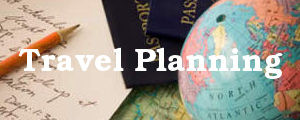Planning a trip around the world is already the start of the adventure. It’s a task which seems daunting and many people told me they “wouldn’t even know where to start”! However, it’s not as hard as you may think but it sure takes a lot of time!
Having a rough idea
I thought a lot about doing a round the world trip before acting on it. Part of doing it is fulfilling a dream, thus knowing what your dreams actually are is a good start!
I went on thinking about the countries I already went to and where I would like to go next. What kind of experiences or cultures I was missing. It lead me to a list of countries I wanted to go, a list which was obviously too long.
It is also a good time to realize what kind of trip you can afford with your budget. It is not too hard to do some kind of estimate if you have traveled before.
Anyway, the planning process is a “coming back to reality” phase. You have to compromise on your dreams, mostly because of time and budget.
First step: read, read, read!
In reality, the very first thing I did is buy two big books full of photos of some of the most beautiful places on earth. I dreamed of those places for several nights!
My research started with a simple Google search: “round the world trip”. Browsing the results, I quickly discovered blogs of people telling their stories, sharing details about their planning, budget and experiences. These blogs lead me to communities and to specialized websites.
I found these blogs to be invaluable resources (which convinced me of the need to share my adventure). They have up-to-date information, authentic stories and lots of photos. They are excellent to help you plan your trip, give tips and have articles about unusual things to do in many countries, some things I would have never thought about!
Here is a short list of blogs and sites I liked or found useful:
- http://travelindependent.info/countries.htm
- http://www.legalnomads.com/
- http://www.neverendingvoyage.com/
- http://www.gobackpacking.com/Blog/
- http://alittleadrift.com/
- http://www.answeringoliver.com/
- http://gqtrippin.com/
- http://everything-everywhere.com/travel-blog-directory/
- http://www.bootsnall.com/
- http://www.perpetualtravel.com/rtw/
- http://www.travelsofmike.com/
To get more structured information I also bought all the Lonely Planet guides for the regions on my list. I only bought the PDF versions, as carrying 10 guide books is obviously not possible. (By the way, the fact that each chapter is a different file is not very practical).
Doing all this reading naturally made me started on my planning. Indeed, I had a better idea of the budget needed, of the best season, etc…
Some countries were eliminated, others were added and step by step I built my itinerary taking in account the season (which I think is very important), the ease of travel, the daily budget…
Google Maps has an awesome feature that let you create your own maps. It’s located under “My Places” in the sidebar.
Budgeting
This is the hard part. And surely, budgeting doesn’t stop after the planning, it’s a permanent process. I find it’s the most stressful aspect of the trip. Having to stop my trip because of bad estimations would be the worst.
It’s obviously impossible to plan every little details for a year of traveling. Thus, I divided the expenses into the following categories:
- daily budget: lodging, food, activities
- expensive activities that I want to do: tours, treks, scuba diving, …
- overland transportation
- flights
Some people say that a good formula to calculate the daily budget is to take the cost of a hostel night and multiply it by 3. This seems to be a good estimation in most cases. I did my estimation using other people budgets, specialized websites like Budget Your Trip (which I find a bit too optimistic) and searching for the cost of hostels on HostelWorld or HostelBookers.
I like to plan a side budget for the most expensive activities which usually are the one I want to do the most (like scuba diving).
Overland transportation means buses and trains. seat61 is the most precious resource you can get about trains. It has information about train routes, fares, tips and tricks for many countries. Bus fares need a little bit more searching but can also easily be found. The Lonely Planet forums have answers for almost all your transportation questions (and many more)!
Flights are the most expensive aspect of the trip. There are two ways of doing it:
- buying the famous “round the world ticket”
- doing it all by yourself
I went the second way as buying the RTW ticket was roughly the same price but offered less flexibility. This is however very dependent on your itinerary. Note that RTW tickets are always restrictive and you will have to buy complementary tickets for short routes.
Doing it by yourself is obviously more work than going through an agency. You’ll have to track the price of flights and remember to book them in advance.
There are now tens of flight comparison engines. At first I used multiple ones to be sure that I got the best price. After a tip from my brother, I found SkyScanner to be really good and now use it almost exclusively.
I also discovered AirTreks which let’s you buy multi-stop flight routes at a reduced price. I will probably use them for the route New Zealand - Hawaii - Peru as they offered me a very good deal.
I have compiled all these information into a spreadsheet which I will talk about in another post.
Sorting out the boring stuff
Now that the fun part is done it’s time for the boring stuff. Leaving for a year is not without consequences. You’re temporarily (?) switching for a new life and it needs some administrative adjustments.
First of all, you’ll need visas but this should have come up in the planning phase. It can be a bit tricky depending on your nationality. As a French passport holder I shouldn’t have much problems. The two most troublesome countries for me are India and China as I need to get the visa before entering. I already have my Indian visa and it wasn’t very hard to get but expensive!
You’ll also need an insurance for at least medical situations and personal liability. You can get insured for many other things (like in case you lost your luggage) but I do not think these options are as important as the first two ones. WorldNomads offers a nice but expensive package. There’s also AVI Marco Polo or APRIL Magellan.
Another medical consideration is getting vaccinated. Don’t underestimate the cost of the needed vaccines as it builds up quickly. I went to a vaccination center in Paris (Institut Pasteur) where they advised me which vaccines to get. This is important because some countries require an International Vaccination Certificate.
Don’t forget to notify your bank as your banker may be worried seeing transactions from all over the world! I already had a Mastercard but I got a Visa as a backup card and for countries that only have one type of provider.
If your country provides it, you may want to get an International Driving Permit. In France, you can ask for one at the Prefecture. It’s free and take 30 minutes to do.
Scan and save as PDF all your documents (passport, permits, etc…) and put them on the cloud (on Dropbox for example). You can encrypt them using Truecrypt. Also keep a photocopy of your passport in your bag and get at least 2 identity photos for each country you’re going to.
Before leaving, you may also need to notify your country’s administration. In France, you should notify your income tax and social security centers. Your country may also provide travel information to some countries which can be interesting. French people can get these information and declare their trip (so the ambassy knows you’re there) on the French diplomacy website.
I think this gives a good overview of the steps to plan any long term trip. Don’t underestimate the time needed to properly plan such a thing: it took me many evenings and weekends!
 Where To Work On The Road: Coworking Spaces
Where To Work On The Road: Coworking Spaces
 Tips To Visit Paris From a Parisian
Tips To Visit Paris From a Parisian
 Money on the Road
Money on the Road
 Looking for a camera? Get the Canon S100
Looking for a camera? Get the Canon S100
 Announcing The Opinionated Backpacker Store
Announcing The Opinionated Backpacker Store

